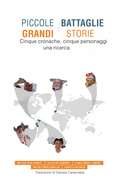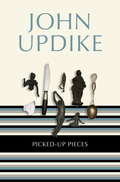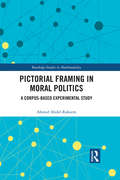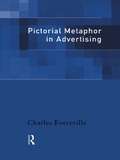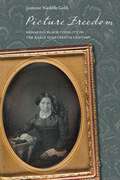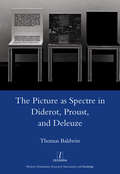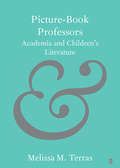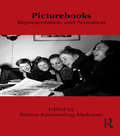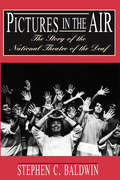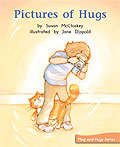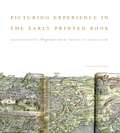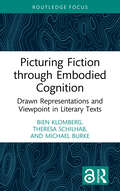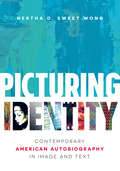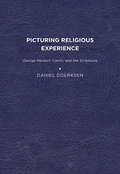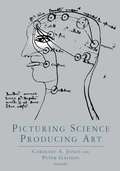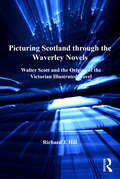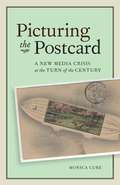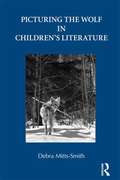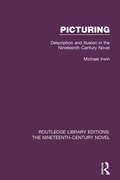- Table View
- List View
Piano in the Vineyard
by Jean JanzenOnce again, Jean Janzen writes mighty poems, finding those heart-stopping human moments for which there is no adequate language. Janzen, a National Endowment for the Arts winner, begins this newest collection of poetry with "Wailing in the Shower" and these arresting stanzas: "After the elation of giving birth, our new daughter fed and sleeping, I stand under the warm water and begin on the high notes-- Madame Butterfly's ecstasy, One fine day in May, the harmony sliding over my body. After the loss of his bride, our friend turns on the guestroom shower and begins his long wailing. It echoes through the house, flows down the stairway, his baritone cries rising and falling. Over and over, the full octaves." And she goes on to mark the full-throated human experience, placing her 42 poems into these sections: "Broken Places," "The Garden," "Carving the Hollow," and, finally, "Piano in the Vineyard." In every poem Janzen is utterly conscious of the unspeakable wonder and terror of being alive. Jean Janzen is a winner of The Creative Writing Fellowship from the National Endowment for the Arts.
Piccole battaglie, grandi storie
by Daniela Caracostas Melissa Silva Franco Nilton Varillas TorresIl libro è la raccolta di cinque racconti di cronaca realizzati da cinque giornalisti latinoamericani. Prologo di Roberto Herrscher, giornalista, reporter specializzato in cultura, società e ambiente, e professore di giornalismo. Laureato in Sociologia presso l’Università di Buenos Aires con Master in Giornalismo alla Columbia University. Dirige e insegna nel Master di Giornalismo BCN_NY, organizzato dalla IL3-Università di Barcellona e l’Università di Columbia a New York. Corrispondente in Spagna della rivista Opera News. Ha impartito lezioni e seminari presso l’Ithaca College (USA), l’Università degli Studi di Milano, Colonia (Germania), Católica de Valparaíso e Finis Terrae (Cile) e insegna nel Master di Giornalismo di Clarín/San Andrés (Argentina), dell’Universidad Complutense di Madrid/ABC (Spagna), tra le altre. Cinque le cronache giornalistiche, cinque i loro autori: 1- La giornalista venezuelana Melissa Silva inizia la serie fornendo il ritratto di un’anziana donna della Corea, Gil Won, che rivela la sua storia e quella di altre 200mila adolescenti durante la Seconda Guerra Mondiale, quando furono sequestrate e violentate e trasformate in “Donne di conforto”. Una storia ancora non raccontata della Seconda Guerra Mondiale. 2- Il giornalista peruviano Luis Felipe Gamarra segue il padre di un poliziotto morto in un torbido scontro con gli indigeni in rivolta. Anche la lotta di Felipe Bazán Caballero è per la memoria e la dignità del figlio. Il suo ultimo ritratto: una foto con il volto insanguinato, scattata mentre tentava di sgomberare una strada dell’ Amazzonia peruviana occupata dagli abitanti della zona. Il padre vuole ritrovarlo, vivo o morto che sia. 3- Il cronista peruviano Nilton Torres Varillas si cimenta con un avventuriero catalano, Anselm Pi, che trovò la Chinkana, un segreto preispanico che la Chiesa non vuole rivelare perché potrebbe cambiare la storia…
Picked-Up Pieces: Essays
by John UpdikeIn John Updike's second collection of assorted prose he comes into his own as a book reviewer; most of the pieces picked up here were first published in The New Yorker in the 1960s and early '70s. If one word could sum up the young critic's approach to books and their authors it would be "generosity": "Better to praise and share," he says in his Foreword, "than to blame and ban." And so he follows his enthusiasms, which prove both deserving and infectious: Kierkegaard, Proust, Joyce, Dostoevsky, and Hamsun among the classics; Borges, Nabokov, Grass, Bellow, Cheever, and Jong among the contemporaries. Here too are meditations on Satan and cemeteries, travel essays on London and Anguilla, three very early "golf dreams," and one big interview. Picked-Up Pieces is a glittering treasury for every reader who likes life, books, wit--and John Updike.
Pictorial Framing in Moral Politics: A Corpus-Based Experimental Study (Routledge Studies in Multimodality)
by Ahmed Abdel-RaheemThis book seeks to extend research on framing beyond linguistic and cognitive perspectives by examining framing in visual and multimodal texts and their impact on moral cognition and attitudes. Drawing on perspectives from frame semantics, blending theory, relevance theory, and pragmatics, the volume establishes a model of "pictorial framing", arguing that subtle alterations in the visual presentation of issues around judgment and choice in such texts impact perception, and applies this framework to a range of case studies from Egyptian, British, and American cartoons and illustrations. The book demonstrates the affordances of applying this framework in enhancing our understanding of both the nature of word-image relations and issues of representation in the op-ed genre, but also in other forms of media more generally. The volume will be of particular interest to students and scholars in multimodality, critical discourse analysis, cognitive linguistics, social psychology, and communication studies.
Pictorial Metaphor in Advertising
by Charles ForcevilleOver the past few decades, research on metaphor has focused almost exclusively on its verbal and cognitive dimensions. In Pictorial Metaphor in Advertising, Charles Forceville argues that metaphor can also occur in pictures and draws on relevant studies from various disciplines to propose a model for the identification, classification, and analysis of 'pictorial metaphors'. By using insights taken from a range of linguistic, artistic and cognitive perspectives for example, interaction and relevance theory, Forceville shows not only how metaphor can occur in pictures, but also provides a framework within which these pictorial metaphors can be analyzed. The theoretical insights are applied to thirty advertisements and billboards of British, French, German and Dutch origin. Apart from substantiating the claim that it makes sense to talk about `pictorial metaphors', the detailed analyses of the advertisements suggest how metaphor theory can be employed as a tool in media studies. Context in its various manifestations plays a key role in the analyses. Furthermore, the results of a small-scale experiment shed light on where general agreement about the meaning of a pictorial metaphor can shade over into other more idiosyncratic but equally valid interpretations. The final chapter sketches the ways in which the insights gained can be used for further research.
Picture Cards, Grade K (Into Reading, Read Aloud Module 10)
by Houghton Mifflin Harcourt Publishing CompanyNIMAC-sourced textbook
Picture Freedom: Remaking Black Visuality in the Early Nineteenth Century (America and the Long 19th Century #20)
by Jasmine Nichole CobbIn the decades leading up to the end of U.S. slavery, many free Blacks sat for daguerreotypes decorated in fine garments to document their self-possession. People pictured in these early photographs used portraiture to seize control over representation of the free Black body and reimagine Black visuality divorced from the cultural logics of slavery. In Picture Freedom, Jasmine Nichole Cobb analyzes the ways in which the circulation of various images prepared free Blacks and free Whites for the emancipation of formerly unfree people of African descent. She traces the emergence of Black freedom as both an idea and as an image during the early nineteenth century. Through an analysis of popular culture of the period—including amateur portraiture, racial caricatures, joke books, antislavery newspapers, abolitionist materials, runaway advertisements, ladies’ magazines, and scrapbooks, as well as scenic wallpaper—Cobb explores the earliest illustrations of free Blacks and reveals the complicated route through visual culture toward a vision of African American citizenship. Picture Freedom reveals how these depictions contributed to public understandings of nationhood, among both domestic eyes and the larger Atlantic world.
Picture as Spectre in Diderot, Proust, and Deleuze
by Thomas Baldwin"The possibility of ekphrasis, the verbal representation of visual imagery, is fundamental to all writing about art, be it art criticism, theory or a passage in a novel. But there is no consensus concerning how such representation works. Some take it for granted that writing about art can result in a precise match between words and visual images. For others, ekphrasis amounts to a kind of virtuoso rivalry, in which the writer aims to outdo the pictorial image that is being described. In close readings of Diderot, Proust and Deleuze, Thomas Baldwin shows how ekphrasis can create a spectral effect. In other words, ekphrastic spectres do not function as fully present stand-ins for given works of art; nor can they be reduced to the status of passive and absent others. Baldwin also explores the ways in which the works of Diderot, Proust and Deleuze inhabit each other as ghostly influences."
Picture-Book Professors: Academia and Children's Literature (Elements in Publishing and Book Culture)
by Melissa TerrasHow is academia portrayed in children's literature? This Element ambitiously surveys fictional professors in texts marketed towards children, who are overwhelmingly white and male, tending to be elderly scientists. Professors fall into three stereotypes: the vehicle to explain scientific facts, the baffled genius, and the evil madman. By the late twentieth century, the stereotype of the male, mad, muddlehead, called Professor SomethingDumb, is formed in humorous yet pejorative fashion. This Element provides a publishing history of the role of academics in children's literature, questioning the book culture which promotes the enforcement of stereotypes regarding intellectual expertise in children's media. This title is also available, with additional material, as Open Access.
Picturebooks: Representation and Narration (Children's Literature and Culture)
by Bettina Kümmerling-MeibauerThis volume discusses the aesthetic and cognitive challenges of modern picturebooks from different countries, such as Denmark, France, Germany, Norway, Spain, Sweden, United Kingdom, and USA. The overarching issue concerns the mutual relationship between representation and narration by means of the picturebooks’ multimodal character. Moreover, this volume includes the main lines of debate and approaches to picturebooks by international leading researchers in the field. Topics covered are the impact of paratexts and interpictorial allusions, the relationship between artists’ books, crossover picturebooks, and picturebooks for adults, the narrative defiance of wordless picturebooks, the representation of emotions in images and text, and the depiction of hybrid characters in picturebooks. The enlargement of the picturebook corpus beyond an Anglo-American picturebook canon opens up new horizons and highlights the diverging styles and genre shifts in modern picturebooks. This tendency also demonstrates the influence of specific authors and illustrators on the appreciation of the picturebook genre, as in the case of Astrid Lindgren’s picturebooks and the picturebooks created by renowned illustrators, such as Anthony Browne, Wolf Erlbruch, Stian Hole, and Bruno Munari. This book will be the definite contribution to contemporary picturebook research for many years to come.
Pictures in the Air: The Story of the National Theatre of the Deaf
by Stephen C. BaldwinNow available in paperback; ISBN 1-56368-140-4
Pictures of Hugs (Fountas & Pinnell LLI Green #Level F, Lesson 67)
by Susan MccloskeyFountas and Pinnell Leveled Literacy Intervention Green System -- 1st Grade
Picturing Canada
by Judith Saltman Gail EdwardsThe study of children's illustrated books is located within the broad histories of print culture, publishing, the book trade, and concepts of childhood. An interdisciplinary history, Picturing Canada provides a critical understanding of the changing geographical, historical, and cultural aspects of Canadian identity, as seen through the lens of children's publishing over two centuries.Gail Edwards and Judith Saltman illuminate the connection between children's publishing and Canadian nationalism, analyse the gendered history of children's librarianship, identify changes and continuities in narrative themes and artistic styles, and explore recent changes in the creation and consumption of children's illustrated books. Over 130 interviews with Canadian authors, illustrators, editors, librarians, booksellers, critics, and other contributors to Canadian children's book publishing, document the experiences of those who worked in the industry.An important and wholly original work, Picturing Canada is fundamental to our understanding of publishing history and the history of childhood itself in Canada.
Picturing Experience in the Early Printed Book: Breydenbach’s Peregrinatio from Venice to Jerusalem
by Elizabeth RossBernhard von Breydenbach’s Peregrinatio in terram sanctam (Journey to the Holy Land), first published in 1486, is one of the seminal books of early printing and is especially renowned for the originality of its woodcuts. In Picturing Experience in the Early Printed Book, Elizabeth Ross considers the Peregrinatio from a variety of perspectives to explain its value for the cultural history of the period. Breydenbach, a high-ranking cleric in Mainz, recruited the painter Erhard Reuwich of Utrecht for a religious and artistic adventure in a political hot spot—a pilgrimage to research the peoples, places, plants, and animals of the Levant. The book they published after their return ambitiously engaged with the potential of the new print medium to give an account of their experience.The Peregrinatio also aspired to rouse readers to a new crusade against Islam by depicting a contest in the Mediterranean between the Christian bastion of the city of Venice and the region’s Muslim empires. This crusading rhetoric fit neatly with the state of the printing industry in Mainz, which largely subsisted as a tool for bishops’ consolidation of authority, including selling the pope’s plans to combat the Ottoman Empire.Taking an artist on such an enterprise was unprecedented. Reuwich set a new benchmark for technical achievement with his woodcuts, notably a panorama of Venice that folds out to 1.62 meters in length and a foldout map that stretches from Damascus to Sudan around the first topographically accurate view of Jerusalem. The conception and execution of the Peregrinatio show how and why early printed books constructed new means of visual representation from existing ones—and how the form of a printed book emerged out of the interaction of eyewitness experience and medieval scholarship, real travel and spiritual pilgrimage, curiosity and fixed belief, texts and images.
Picturing Experience in the Early Printed Book: Breydenbach’s Peregrinatio from Venice to Jerusalem
by Elizabeth RossBernhard von Breydenbach’s Peregrinatio in terram sanctam (Journey to the Holy Land), first published in 1486, is one of the seminal books of early printing and is especially renowned for the originality of its woodcuts. In Picturing Experience in the Early Printed Book, Elizabeth Ross considers the Peregrinatio from a variety of perspectives to explain its value for the cultural history of the period. Breydenbach, a high-ranking cleric in Mainz, recruited the painter Erhard Reuwich of Utrecht for a religious and artistic adventure in a political hot spot—a pilgrimage to research the peoples, places, plants, and animals of the Levant. The book they published after their return ambitiously engaged with the potential of the new print medium to give an account of their experience.The Peregrinatio also aspired to rouse readers to a new crusade against Islam by depicting a contest in the Mediterranean between the Christian bastion of the city of Venice and the region’s Muslim empires. This crusading rhetoric fit neatly with the state of the printing industry in Mainz, which largely subsisted as a tool for bishops’ consolidation of authority, including selling the pope’s plans to combat the Ottoman Empire.Taking an artist on such an enterprise was unprecedented. Reuwich set a new benchmark for technical achievement with his woodcuts, notably a panorama of Venice that folds out to 1.62 meters in length and a foldout map that stretches from Damascus to Sudan around the first topographically accurate view of Jerusalem. The conception and execution of the Peregrinatio show how and why early printed books constructed new means of visual representation from existing ones—and how the form of a printed book emerged out of the interaction of eyewitness experience and medieval scholarship, real travel and spiritual pilgrimage, curiosity and fixed belief, texts and images.
Picturing Fiction through Embodied Cognition: Drawn Representations and Viewpoint in Literary Texts (Routledge Focus on Linguistics)
by Michael Burke Bien Klomberg Theresa SchilhabThis concise volume addresses the question of whether or not language, and its structure in literary discourses, determines individuals’ mental ‘vision,’ employing an innovative cross-disciplinary approach using readers’ drawings of their mental imagery during reading. The book engages in critical dialogue with the perceived wisdom in stylistics rooted in Roger Fowler’s seminal work on deixis and point of view to test whether or not this theory can fully account for what readers see in their mind's eye and how they see it. The work draws on findings from a study of English and Dutch across a range of literary texts, in which participants read literary text fragments and were then asked to immediately draw representations of what they had seen envisioned. Building on the work of Fowler and more recent theoretical and empirical language-based studies in the area, Klomberg, Schilhab and Burke argue that models from embodied cognitive science can help account for anomalies in evidence from readers’ drawings, indicating new ways forward for interdisciplinary understandings of individual meaning construction in literary textual interfaces. This book will be of interest to students and scholars in stylistics, cognitive psychology, rhetoric, and philosophy, particularly those working in embodied cognition.
Picturing Fiction through Embodied Cognition: Drawn Representations and Viewpoint in Literary Texts (Routledge Focus on Linguistics)
by Michael Burke Bien Klomberg Theresa SchilhabThis concise volume addresses the question of whether or not language, and its structure in literary discourses, determines individuals’ mental "vision," employing an innovative cross-disciplinary approach using readers’ drawings of their mental imagery during reading. The book engages in critical dialogue with the perceived wisdom in stylistics rooted in Roger Fowler’s seminal work on deixis and point of view to test whether or not this theory can fully account for what readers see in their mind's eye and how they see it. The work draws on findings from a study of English and Dutch across a range of literary texts, in which participants read literary text fragments and were then asked to immediately draw representations of what they had seen envisioned. Building on the work of Fowler and more recent theoretical and empirical language-based studies in the area, Klomberg, Schilhab, and Burke argue that models from embodied cognitive science can help account for anomalies in evidence from readers’ drawings, indicating new ways forward for interdisciplinary understandings of individual meaning construction in literary textual interfaces.This book will be of interest to students and scholars in stylistics, cognitive psychology, rhetoric, and philosophy, particularly those working in the field of embodied cognition.The Open Access version of this book, available at http://www.taylorfrancis.com, has been made available under a Creative Commons Attribution-Non-Commercial (CC-BY-NC-) 4.0 license.
Picturing Identity: Contemporary American Autobiography in Image and Text
by Hertha D. WongIn this book, Hertha D. Sweet Wong examines the intersection of writing and visual art in the autobiographical work of twentieth- and twenty-first-century American writers and artists who employ a mix of written and visual forms of self-narration. Combining approaches from autobiography studies and visual studies, Wong argues that, in grappling with the breakdown of stable definitions of identity and unmediated representation, these writers-artists experiment with hybrid autobiography in image and text to break free of inherited visual-verbal regimes and revise painful histories. These works provide an interart focus for examining the possibilities of self-representation and self-narration, the boundaries of life writing, and the relationship between image and text. Wong considers eight writers-artists, including comic-book author Art Spiegelman; Faith Ringgold, known for her story quilts; and celebrated Indigenous writer Leslie Marmon Silko. Wong shows how her subjects formulate webs of intersubjectivity shaped by historical trauma, geography, race, and gender as they envision new possibilities of selfhood and fresh modes of self-narration in word and image.
Picturing Religious Experience: George Herbert, Calvin, and the Scriptures
by Daniel DoerksenLittle has been said about the relationship of Herbert’s writings to those of John Calvin, yet the latter were abundant and influential in Herbert’s Church of England. Accordingly Picturing Religious Experience studies Herbert’s poetry in relation to those writings, particularly regarding “spiritual conflicts,” which the poet himself said would be found depicted in his book of poems. Much more than is generally realized, Calvin wrote about the experience of living the Christian life—which is also Herbert’s subject in many of his poems. Altogether, this study maintains that Herbert owes to his religious orientation not just themes or details, but an impulse to observe and depict the inner life, and scriptural patterns which significantly contribute to the substance and literary excellence of The Temple. Published by University of Delaware Press. Distributed worldwide by Rutgers University Press.
Picturing Science, Producing Art
by Peter Galison Caroline A. JonesFirst Published in 1998. Routledge is an imprint of Taylor & Francis, an informa company.
Picturing Scotland through the Waverley Novels: Walter Scott and the Origins of the Victorian Illustrated Novel
by Richard J. HillInnovative and accessibly written, Picturing Scotland examines the genesis and production of the first author-approved illustrations for Sir Walter' Scott's Waverley novels in Scotland. Consulting numerous neglected primary sources, Richard J. Hill demonstrates that Scott, usually seen as disinterested in the mechanics of publishing, actually was at the forefront of one of the most innovative publishing and printing trends, the illustrated novel. Hill examines the historical precedents, influences, and innovations behind the creation of the illustrated editions, tracking Scott's personal interaction with the mechanics of the printing and illustration process, as well as Scott's opinions on visual representations of literary scenes. Of particular interest is Scott's relationships with William Allan and Alexander Nasmyth, two important early nineteenth-century Scottish artists. As the first illustrators of the Waverley novels, their work provided a template for one of the more lucrative publishing phenomena. Informed by meticulous close readings of Scott's novels and augmented by a bibliographic catalogue of illustrations, Picturing Scotland is an important contribution to Scott studies, the development of the illustrated novel, and publishing history.
Picturing the Page: Illustrated Children’s Literature and Reading under Lenin and Stalin
by Megan SwiftBased on sources from rare book libraries in Russia and around the world, Picturing the Page offers a vivid exploration of illustrated children’s literature and reading under Lenin and Stalin – a period when mass publishing for children and universal public education became available for the first time in Russia. By analysing the illustrations in fairy tales, classic "adult" literature reformatted for children, and war-time picture books, Megan Swift elucidates the vital and multifaceted function of illustrated children’s literature in repurposing the past. Picturing the Page demonstrates that while the texts of the past remained fixed, illustrations could slip between the pages to mediate and annotate that past, as well as connect with anti-religious, patriotic, and other campaigns that were central to Soviet children’s culture after the 1917 Revolution.
Picturing the Postcard: A New Media Crisis at the Turn of the Century
by Monica CureThe first full-length study of a once revolutionary visual and linguistic medium Literature has &“died&” many times—this book tells the story of its death by postcard. Picturing the Postcard looks to this unlikely source to shed light on our collective, modern-day obsession with new media. The postcard, almost unimaginably now, produced at the end of the nineteenth century the same anxieties and hopes that many people think are unique to twenty-first-century social media such as Facebook or Twitter. It promised a newly connected social world accessible to all and threatened the breakdown of authentic social relations and even of language. Arguing that &“new media&” is as much a discursive object as a material one, and that it is always in dialogue with the media that came before it, Monica Cure reconstructs the postcard&’s history through journals, legal documents, and sources from popular culture, analyzing the postcard&’s representation in fiction by well-known writers such as E. M. Forster and Edith Wharton and by more obscure writers like Anne Sedgwick and Herbert Flowerdew. Writers deployed uproar over the new medium of the postcard by Anglo-American cultural critics to mirror anxieties about the changing nature of the literary marketplace, which included the new role of women in public life, the appeal of celebrity and the loss of privacy, an increasing dependence on new technologies, and the rise of mass media. Literature kept open the postcard&’s possibilities and in the process reimagined what literature could be.
Picturing the Wolf in Children's Literature (Children's Literature and Culture #69)
by Debra Mitts-SmithFrom the villainous beast of “Little Red Riding Hood” and “The Three Little Pigs,” to the nurturing wolves of Romulus and Remus and Rudyard Kipling’s The Jungle Book, the wolf has long been a part of the landscape of children’s literature. Meanwhile, since the 1960s and the popularization of scientific research on these animals, children’s books have begun to feature more nuanced views. In Picturing the Wolf in Children’s Literature, Mitts-Smith analyzes visual images of the wolf in children’s books published in Western Europe and North America from 1500 to the present. In particular, she considers how wolves are depicted in and across particular works, the values and attitudes that inform these depictions, and how the concept of the wolf has changed over time. What she discovers is that illustrations and photos in works for children impart social, cultural, and scientific information not only about wolves, but also about humans and human behavior. First encountered in childhood, picture books act as a training ground where the young learn both how to decode the “symbolic” wolf across various contexts and how to make sense of “real” wolves. Mitts-Smith studies sources including myths, legends, fables, folk and fairy tales, fractured tales, fictional stories, and nonfiction, highlighting those instances in which images play a major role, including illustrated anthologies, chapbooks, picture books, and informational books. This book will be of interest to children’s literature scholars, as well as those interested in the figure of the wolf and how it has been informed over time.
Picturing: Description and Illusion in the Nineteenth Century Novel (Routledge Library Editions: The Nineteenth-Century Novel #21)
by Michael IrwinFirst published in 1979. Most of the great nineteenth century novelists strove to render in words the people and places that they invented and most readers of fiction picture in their imagination these characters and scenes. This book investigates both types of ‘picturing’, exploring the principles and problems concerned, and sheds light on the workings of fiction — reassessing a number of famous novels in the process. By so doing, this work relates the academic study of the novel to the writing and reading of fiction, and the teaching of creative writing. This book will appeal to students of literature.

